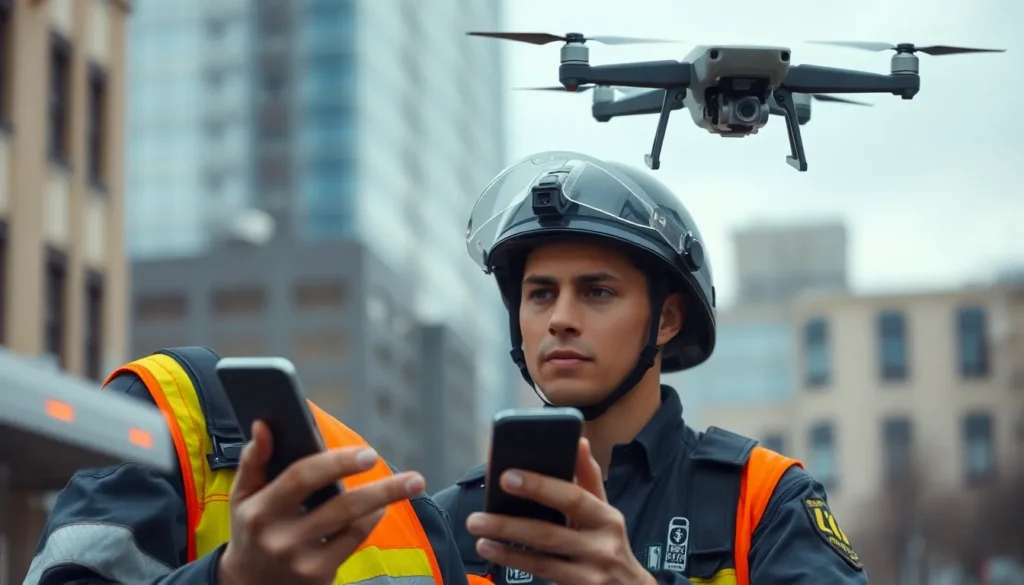Table of Contents
ToggleWhen disaster strikes, every second counts. Imagine a world where technology swoops in like a superhero, turning chaos into calm and confusion into clarity. That’s the promise of technology-enhanced emergency response. From drones delivering medical supplies to apps connecting citizens with first responders, innovation is transforming how emergencies are managed and lives are saved.
Overview of Technology-Enhanced Emergency Response
Technology plays a crucial role in modern emergency response systems. Drones deliver medical supplies and equipment swiftly, reaching remote or inaccessible areas. These unmanned aerial vehicles enhance response times significantly, allowing first responders to focus on critical tasks.
Mobile applications connect citizens directly with emergency services, streamlining communication during crises. These platforms often feature real-time updates and alerts, helping individuals stay informed about unfolding situations.
Data analytics optimizes resource allocation and decision-making, ensuring that responders know where to direct their efforts. Sensors and IoT devices offer real-time monitoring of emergencies, providing vital insights into the situation on the ground.
Geographic Information Systems (GIS) improve situational awareness by mapping incident locations and resource availability. This technology enables responders to visualize data and strategize effectively, leading to better outcomes during events like natural disasters.
Training simulations equipped with virtual reality enhance preparedness for emergency personnel. These immersive experiences enable responders to practice their skills in realistic scenarios, boosting their confidence and efficiency when real emergencies arise.
Artificial intelligence aids in predicting potential emergencies, allowing proactive measures to be implemented. By analyzing historical data and patterns, AI identifies risk factors and contributes to more effective planning.
Incorporating technology into emergency response not only saves time but also saves lives. Each advancement made in this field contributes to more coordinated and efficient crisis management.
Key Technologies in Emergency Response

Technology plays a vital role in enhancing emergency response efforts. Various tools contribute to better outcomes in critical situations.
Communication Tools
Mobile applications facilitate direct communication between citizens and emergency responders. These tools provide essential real-time updates during emergencies. Messaging services also enable coordination among teams, ensuring efficient resource deployment. Additionally, social media platforms help disseminate information quickly, guiding individuals on how to stay safe. This collective communication framework improves overall situational awareness and response time.
Data Analytics
Data analytics empowers emergency management by optimizing resource allocation and decision-making. Analyzing historical data allows responders to identify patterns and anticipate potential incidents. Predictive analytics can determine resource needs based on past emergency occurrences. This analysis aids in planning for effective responses, reducing wait times and improving outcomes. Real-time data further supports dynamic decision-making during crises.
Drones and Robotics
Drones revolutionize emergency response by delivering medical supplies and assessing disaster areas. These unmanned aerial vehicles reach remote or hazardous locations quickly, providing critical support. Robotics enhances search and rescue operations, enabling teams to locate victims in difficult environments. By capturing aerial imagery, drones offer valuable situational intelligence to responders. The integration of these technologies significantly improves efficiency in emergency management practices.
Benefits of Technology-Enhanced Emergency Response
Technology significantly enhances emergency response by improving efficiency and effectiveness during crises. Innovations streamline communication and optimize resource allocation.
Improved Response Times
Response times improve dramatically with the use of drones for medical supply deliveries. In remote areas, these drones transport urgent supplies within minutes, often reducing wait times from hours to mere moments. Mobile applications provide real-time alerts to emergency teams, ensuring they reach the scene faster. Advanced data analytics allow for better route planning, factoring in traffic and obstacles. Historical data guides responders, helping them anticipate potential delays and adjust their strategies accordingly. Lives often depend on these timely interventions, highlighting the critical nature of swift emergency responses.
Enhanced Coordination
Coordination among emergency services strengthens significantly through technology integration. Apps connect citizens directly with responders, ensuring vital information flows seamlessly. Social media platforms serve as a powerful tool for real-time updates, keeping the public informed and engaged. Command centers utilize Geographic Information Systems to visualize incidents and coordinate resources efficiently. The ability to track personnel and assets in real-time aids in minimizing confusion during crises. Ultimately, effective coordination fosters a unified response, allowing teams to tackle emergencies with precision and agility.
Challenges and Limitations
Technology-enhanced emergency response presents several challenges and limitations that impact its effectiveness.
Cybersecurity Concerns
Cybersecurity issues pose significant risks to emergency response systems. Threats from hackers can disrupt communication networks, jeopardize sensitive data, and lead to misinformation. Attackers might manipulate information, causing confusion during critical times. It’s essential to implement robust security protocols to safeguard data integrity and maintain public trust. Regular software updates and training for emergency personnel can mitigate potential vulnerabilities. Investing in advanced cybersecurity measures becomes vital to ensure the uninterrupted functionality of technological tools during emergencies.
Accessibility Issues
Access to technology remains a challenge in many communities, affecting response effectiveness. Disparities in tech access hinder timely communication and resource distribution. Rural areas often experience less reliable internet and mobile service than urban locations, creating delays in emergency response. Multilingual capabilities in apps address language barriers, but not all individuals are tech-savvy. Emergency responders must consider these factors and develop alternative communication methods. Utilizing community engagement and outreach programs can improve awareness and promote inclusivity in technology usage during emergencies.
Future Trends in Emergency Response Technology
Rapid advancements in emergency response technology are shaping the future landscape. Drones equipped with advanced sensors and artificial intelligence will deliver vital supplies, improving access in hard-to-reach areas. Mobile applications increasingly feature augmented reality elements that enhance situational awareness for both responders and citizens.
Smart sensors are pivotal in real-time monitoring of emergencies. Data analytics enable responders to assess situations more accurately, predicting outcomes based on historical patterns. Geographic Information Systems will integrate even more with emergency management systems, providing dynamic maps to visualize incidents and resource statuses.
Collaboration tools are evolving. Social media platforms will increasingly facilitate interaction between the public and emergency services, allowing for immediate feedback and updates. Wearable technology for first responders will gather health metrics, ensuring safety and effectiveness in crisis situations.
Training methods are set to undergo transformation as well. Virtual reality simulations will become common, enabling responders to practice various scenarios. This approach will enhance preparedness and adaptability during real emergencies.
Blockchain technology holds potential to secure communication channels, enhancing data integrity and trust in emergency management systems. The use of autonomous vehicles for transport and logistics will streamline operations significantly, increasing the speed of response.
Challenges persist despite these advancements. Cybersecurity remains a critical concern as malicious actors seek to exploit vulnerabilities in emergency communication systems. Ensuring equity remains vital too, as rural areas often lack access to reliable technology. Prioritizing inclusivity in technology usage will maximize the benefits of new innovations in emergency response systems.
Technology’s role in emergency response is undeniably transformative. As innovations continue to evolve they enhance efficiency and effectiveness in crisis management. The integration of tools like drones mobile apps and data analytics not only streamlines operations but also fosters better communication between citizens and responders.
However challenges such as cybersecurity risks and accessibility issues must be addressed to ensure equitable access to these advancements. Looking to the future the ongoing development of technologies will likely provide even greater capabilities for emergency responders. Embracing these innovations while tackling their associated challenges will ultimately lead to safer communities and more effective emergency management strategies.







